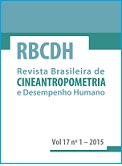Efeito de quatro semanas de treinamento de sprints repetidos sobre índices fisiológicos em atletas de futsal
DOI:
https://doi.org/10.1590/1980-0037.2015v17n1p91Resumo
O objetivo deste estudo foi investigar os efeitos do treinamento de sprints repetidos (RSA) nos índices fisiológicos e neuromusculares em atletas de futsal sub17 durante a temporada competitiva. Quatorze jogadores foram divididos em dois grupos: grupo intervenção (n = 8) e controle (n = 6). Ambos os grupos desempenharam testes de sprints máximos repetidos (40-m MST), teste de corrida intermitente (teste de Carminatti) e saltos verticais antes e depois do período de treinamento. O grupo intervenção foi submetido a um programa adicional de quatro semanas de RSA, duas vezes por semana, enquanto o grupo controle manteve a rotina normal de treinos. Não houve interação significante entre tempo e grupo para todas as variáveis analisadas (p > 0.05). Entretanto, um efeito principal significante foi observado para o tempo (p < 0.01), indicando um aumento na velocidade do ponto de deflexão da frequência cárdica (VHRDP) e na performance do salto contínuo, bem como, diminuição no pico de lactato (40m-LACpeak) e no decréscimo dos sprints após o treinamento em ambos os grupos. Ainda, baseado no effect size (ES), maiores mudanças com relevância prática foram verificadas para o grupo intervenção em importantes variáveis tais como: pico de velocidade (ES = 0,71) VHRDP (ES = 0,83) e 40m-LACpeak (ES = 1,00). Este estudo demonstrou que o treinamento de RSA e a rotina normal de treinos são igualmente efetivos em produzir mudanças nas variáveis analisadas durante um curto período de intervenção. Porém, o effect size sugere que quatro semanas de treinamento de RSA pode ser um tempo mínimo para que ocorram as primeiras alterações no desempenho físico de atletas de futsal.
Downloads
Publicado
Edição
Seção
Licença

Direitos Autorais para artigos publicados nesta revista são do autor, com direitos de primeira publicação para a revista. Em virtude da aparecerem nesta revista de acesso público, os artigos são de uso gratuito, com atribuições próprias, em aplicações educacionais e não-comerciais, desde que seja dada a atribuição. Esta obra foi licenciada com uma Licença Creative Commons Atribuição 4.0 Internacional - CC BY


